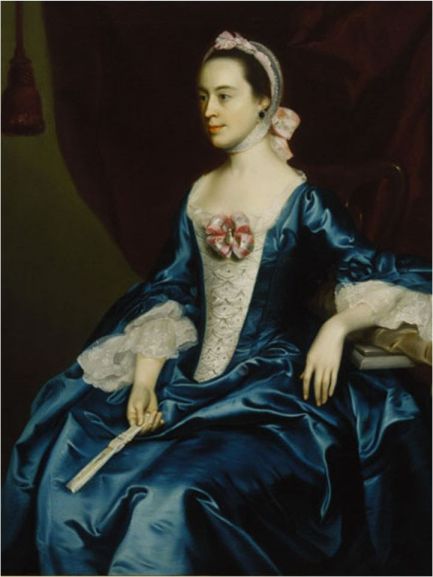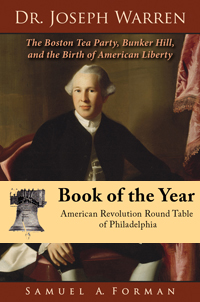by Samuel A. Forman
I believe that the sitter portrayed in John Singleton Copley’s mysterious Lady in a Blue Dress is Miss Mercy Scollay of Boston at age 22. The striking, full size portrait resides at the Terra Foundation Museum in Chicago.[i]
In an age of visuals, I decided that an image of Miss Scollay would enhance the telling of her story and of her relationship with Joseph Warren. Yet no likeness of Miss Mercy Scollay is known to exist. Would the earnest desire of the biographer of showing Miss Scollay’s likeness, one by so distinguished an artist as Copley no less, color my historiographic reasoning and distort my attribution? Said another way, am I fooling myself that The Lady is Mercy Scollay in a misguided quest to conform to modern, visually oriented story telling conventions? How dare the historical biographer invade the turf of art historians!
I shall summarize here the rationale for my identification of Miss Mercy Scollay. It is based on previous art history scholarship and judgments, a striking similarity of a known sitter in a Copley miniature portrait, and genealogical inference. I leave it to you, gentle reader of Dr. Joseph Warren on the Web-drjosephwarren.com, whether I have solved a 250 year old mystery, or have painted myself as a fool.
Miss Scollay (1741-1826) was Joseph Warren’s fiancée at the time of his death during the Battle of Bunker Hill and an unsung Daughter of Liberty. Some of her letters and possible literary compositions appear on this website here, here, and here. To find others by and about her, type in ‘Mercy Scollay’ into the Search field on the right column of this webpage. I will post more full-text transcriptions concerning her in the future. I posted a summary of what is known about Mercy’s life on Journal of the American Revolution-all things liberty.com as A Valentine to Miss Mercy Scollay. I devote an entire Appendix to her in my biography of Joseph Warren. The latter is the most extensive discussion of her ever in print.
Art historians have long been puzzled by the identity of The Lady in a Blue Dress.[ii] The magnificent portrait descended in Copley’s family, as opposed to the subject’s, and is unmarked as to date and sitter. They speculate that it is a young woman connected with the Scollay or Hutchinson families of Boston, but offer no explanation or speculation why Copley himself would have kept it in his possession. Experts date it to about 1763 on stylistic grounds in comparison with many Copley portraits of certain date. The same art historians lean toward a Scollay woman because Copley painted the elder John Scollay and his wife Mrs. Mercy Greenleaf Scollay in the early 1760s and did commissions for other Scollay-associated people through 1774. Portraits of other immediate Scollay family members like Mercy in that timeframe are therefore plausible. In contrast, Copley’s surviving account books show no work for the Hutchinson clan after 1761.
Meanwhile, the Copley miniature of Mrs. Deborah Scollay Melvill[e], Mercy’s older sister, also dated to the early 1760s, exhibits a striking resemblance to the Lady in a Blue Dress. The miniature, about 2 1/2 by 3 1/2 inches oval, resides at the Worcester Art Museum in Worcester, Massachusetts. It appears on the first line of the Image tab gallery on this website, where you can toggle between it and The Lady in a Blue Dress. The miniature’s provenance and sitter identities are not in doubt, having descended through the Mellvill[e] family. It is therefore more likely, based on this visual evidence, that the Lady in a Blue Dress is also a Scollay. That is where art historians have left things for decades.
As a general matter art historians can be more interested in the artist’s development and context than to the identity of an individual sitter. Considering the mode and purpose of the original commissioning of these portraits, it is ironic that their institutional conservators take little interest in such a key point for the biographer. I wonder if there is an unspoken perverse incentive not to identify the sitter, because such might detract from thematic conclusions asserted for a nameless and generic Lady in a Blue Dress, inhabiting British North America during the late Colonial Atlantic world, rather than Mercy Scollay of Boston’s story in particular.
In fairness there has been some excellent scholarship published on Colonial American portraiture in recent years.[iii] To the extent that The Lady has come up lately, there has been more interest in the dress than who is wearing it.[iv] I diverge. Let us come back to the sitter attribution.
From here on, these are my own speculations:
At first glance the similarity between Deborah Scollay Melvill[e] and The Lady in a Blue Dress is so striking as to suggest that they are one and the same person. Even considering Copley’s artistic variation among renderings of the same person, the Worcester miniature and the Lady are different people, both painted by Copley around the same time. High resolution files I have obtained from each museum where the works reside reveal that Deborah Scollay Melvill[e] is a redhead. The Lady is a brunette. They have different jaw lines. Copley authorities note that he could be fanciful at times with women’s props and clothing in his portraits, but bordered on unforgiving (warts and all) in capturing facial features.
Construction of the Scollay family tree from New England Historical and Genealogical Society[v]sources reveals five Scollay sisters in the immediate family, four of them living to adulthood. Here is a genealogist’s overview of the clan. I am more confident of the children’s’ vital dates than of the parents:
- Father – John Scollay. Born 1711. Died 1790 [b&w Copley pastel at Pennsylvania Academy of Fine Arts, Philadelphia]
- Mother – Mercy Greenleaf Scollay. Born 1719? Married Mar 10, 1735. Died Oct 9, 1793. [Copley oil portrait extant. Copley b&w pastel at Harvard University’s Fogg Art Museum.]
- (child) Deborah Scollay. baptized 1736. Married John Melvill[e] Apr 13, 1762. [Copley portrait miniature at Worcester Art Museum is pictured in this article.]
- (child) Mercy Scollay. Born 1741. Died Medfield Jan 8, 1826. Never married; no children.
- (child) James Scollay. Born Aug 17, 1743. Died Aug 1, 1747.
- (child) John Scollay, Jr. Born May 24, 1745. Died Aug 1775.
- (child) Daniel Scollay – Born Feb 26, 1746. Died May 11, 1748
- (child) James Scollay – Born Jun 9, 1749. Died Feb 22, 1768, drowned.
- (child) Mary Scollay – Born Mar 4, 1752. Died Oct 1, 1752.
- (child) Daniel Scollay – Born Jan 20, 1754. Died Jan 2, 1768, drowned.
- (child) William Scollay – Born Nov 24, 1756. “Colonel” Married Catherine ____. Son William Scollay born Sep 7, 1785. This Scollay took the male line into the 19th century and was a real estate developer around Scollay Square.
- (child) Priscilla Scollay (1755 – 1833?). Married Thomas Melvill[e] (1751-1832) Aug 30, 1774 [Dexter Memorandum as source document]. Both Deborah and Priscilla married Melvill[e]s; the genealogist must not get confused. Priscilla is the grandmother of Herman Melville, making Mercy the classic author’s great aunt. [Portrait of Priscilla as an old woman extant at the Old State House Museum of the Bostonian Society.]
- (child) Mary Scollay – Baptized Feb 17, 1760. Married Reverend Thomas Prentiss of Medfield, MA as his second wife, Jan 20, 1789. Died 1841. Mercy went to live in the household of her baby sister Mary Scollay Prentiss in Medfield, Massachusetts, starting in the late 1790s.
Assuming that the 1763 dates are correct for both the miniature of redhead Deborah Scollay Melvill[e], and Copley’s brunette Lady in a Blue Dress is indeed another Scollay daughter, then it must be Mercy. Miss Mercy would have been 22 in 1763, an age which appears consonant with the appearance of The Lady in a Blue Dress. Younger surviving sisters Priscilla would have been only 8 and Mary 3 years old in 1763.
Documentation survives of Mercy’s services to Mrs. Pelham, J.S. Copley’s mother, when the latter was very old in the 1790s and living in the big house on Beacon Hill. John Singleton Copley was directly involved in these arrangements by letter, though he had permanently left Boston back in 1774 for a second career as a painter in Great Britain. I infer a friendship between Copley and Miss Mercy Scollay in more peaceful, pre-Revolutionary times.[vi]
If you share my belief that The Lady is Miss Mercy Scollay, a mystery remains as to why she or other Scollays never took possession of the painting, and why Copley kept it.
[i] John Singleton Copley (1738-1815), Portrait of a Lady in a Blue Dress, 1763. At Chicago: Terra Foundation for American Art, Daniel J. Terra Collection, accession 1992.28. Oil on canvas, Image: 50 1/4 x 39 3/4 in. (127.6 x 101.0 cm), in frame: 56 1/4 x 46 1/4 x 3 3/4 in. (142.9 x 117.5 x 9.5 cm). webpage http://72.9.254.50/view/objects/asitem/People$0040173/0?t:state:flow=2e7914eb-ba77-408b-b529-8224e71c9a66, last accessed February 17, 2013.
[ii] Prown, Jules David. John Singleton Copley in America, 1738–1774. Cambridge, Massachusetts: Harvard University Press, 1966. Fig. 118 (black & white) is Copley’s Lady in a Blue Dress.
[iii] Barratt, Carrie Rebora, and Staiti. Paul. John Singleton Copley in America. New York: Metropolitan Museum of Art, 1995.
[iv] Lovell, Margaretta M. Art in a Season of Revolution: Painters, Artisans, and Patrons in Early America. Philadelphia: University of Pennsylvania Press, 2007. See chapter 3.
[v] New England Historical and Genealogical Society on-line compendium of 18th century Boston church and town vital records. Composite of the Scollay family tree compiled from NEHGS search engine of its digitized resources: www.americanancestors.org/home.html.
[vi] Slade, Denison Roger. “Henry Pelham, the Half-Brother of John Singleton Copley.” Transactions of the Colonial Society of Massachusetts 5, (1898): 193-211. This scholarly article cites two intriguing primary sources. Miss Mercy Scollay is identified as a minor beneficiary of Mary Pelham’s (mother of John Singleton Copley) estate, probate May 11, 1789 “To Mercy Scollay, spinster, daughter of John Scollay oe12 (12 pounds).” The original source documents are in probate records for Suffolk County, where Boston is located. p. 209 notes: “Mrs Pelham’s Will [mother to Henry Pelham and half brother John Singleton Copley], dated 21 August 1781, was proved 11 May 1789. Her executor was her step-son, Charles Pelham whom she charged to take care of the real estate in Boston belonging to her son Copley. Legacies were left to her Executor, to his daughter Harriot, -“my god-daughter’- to “my good friend Mercy Scolllay,” and to John Allen of Boston, tailor. [NEHGS Suffolk Probate Files, No. 19, 268]. A letter from Charles Pelham, executor of Mrs. Pelham’s estate, to Henry Bromfield, Esq., dated Boston May 1, 1789 mentions Miss Scollay and indicates a close intimacy with Mrs. Pelham (p. 210): “There is in the house some pictures and Miss Scollay thinks some other things belonging to you. I shall be glad you would send me an account of them, and your orders concerning them, which shall be observ’d with care and punctuality.”

 Follow
Follow